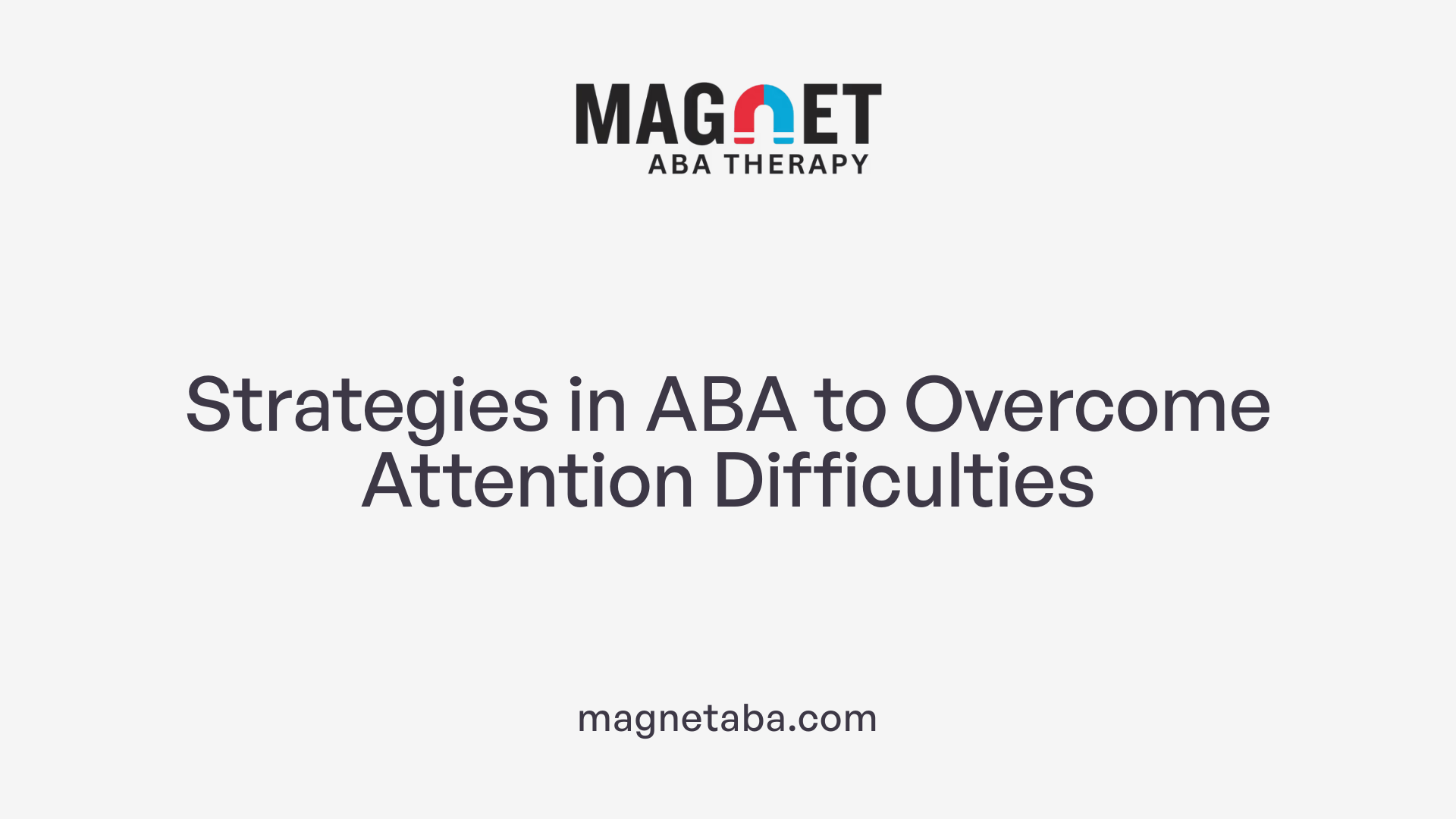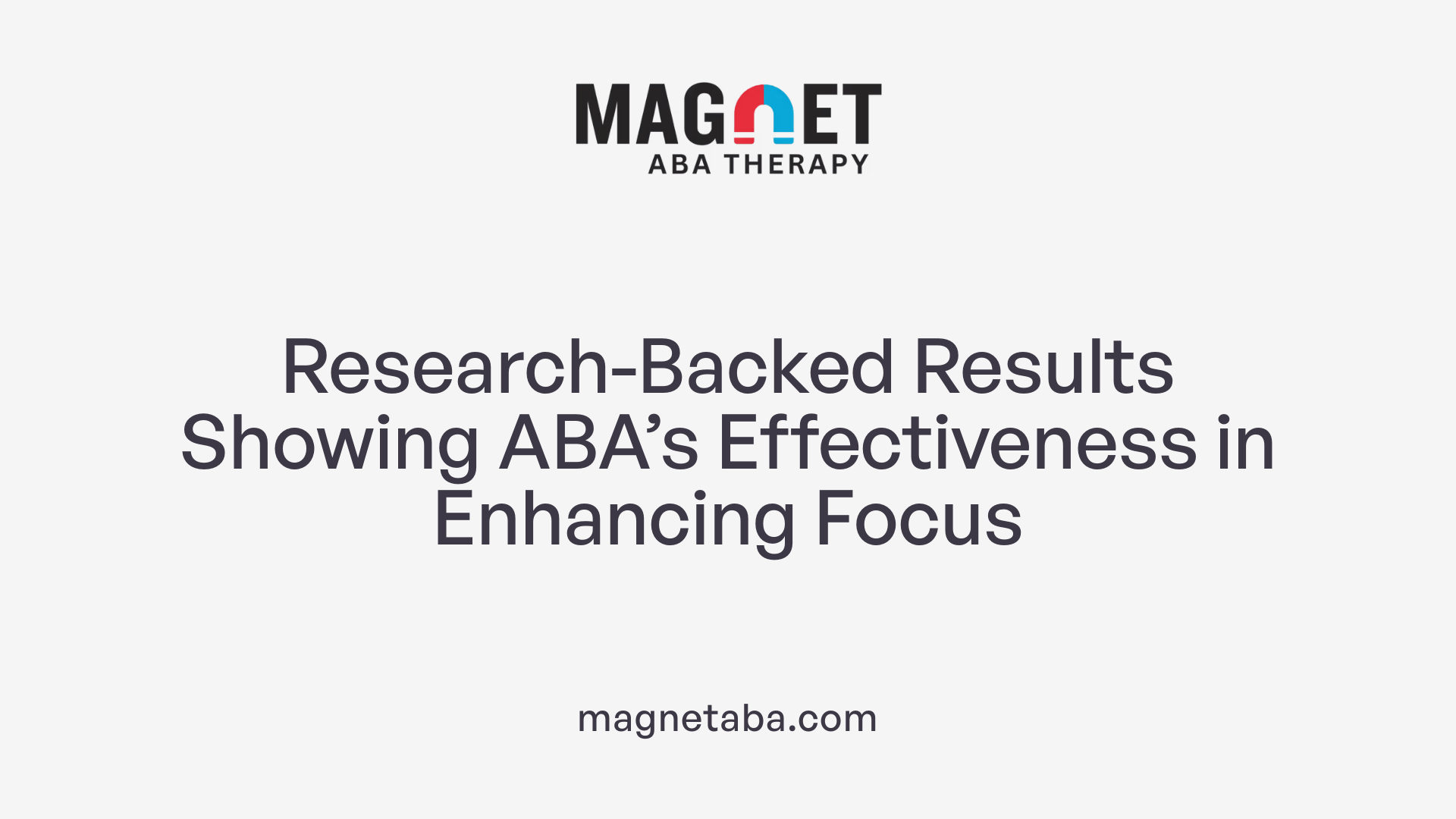Exploring ABA's Role in Behavioral and Cognitive Development
Applied Behavior Analysis (ABA) has emerged as a foundational therapy for children with Autism Spectrum Disorder (ASD), particularly noted for its scientifically backed effectiveness in improving critical developmental areas. This article delves into how ABA therapy directly influences attention and focus, key areas often challenging for children with ASD, revealing the structured approaches and techniques that contribute to meaningful behavioral change and cognitive improvements.
What Is Applied Behavior Analysis (ABA) Therapy?
Definition and scientific foundation of ABA therapy
Applied Behavior Analysis (ABA) therapy is a scientifically grounded approach focused on improving socially meaningful behaviors, especially in children with autism spectrum disorder (ASD). Rooted in the principles of behaviorism, ABA analyzes how behavior is acquired and maintained by examining the relationship between environmental triggers and consequences. The therapy applies evidence-based techniques to modify behavior systematically.
Behaviorism principles underlying ABA
ABA is based on behaviorism, emphasizing that behaviors are learned and can be shaped by environmental influences. The therapy uses reinforcement, primarily positive reinforcement, to increase desired behaviors. Undesirable behaviors are decreased through strategies that consider antecedents and consequences, often by reinforcing alternative, appropriate behaviors.
Goals of ABA therapy in improving behaviors and skills
The primary aim of ABA therapy is to enhance social interaction, communication, and daily living skills, enabling individuals to gain independence and improved quality of life. It targets increasing beneficial behaviors like verbal and non-verbal communication, social participation, attention, and adaptive skills while reducing challenging behaviors like agitation and repetitive actions.
Individualized ABA programs and continual assessment
ABA programs are highly tailored to each person's unique needs, starting with a comprehensive behavior assessment and clear goal setting. These personalized interventions use ongoing data collection and analysis to monitor progress and refine methods. This continuous evaluation allows therapists to adapt the approach effectively for meaningful, lasting improvements.
Common ABA methodologies
Common ABA methods include:
- Discrete Trial Training (DTT): Breaking skills into small components with repeated practice.
- Modeling: Demonstrating behaviors for the individual to imitate.
- Prompting and Prompt Fading: Providing cues that are gradually removed.
- Task Analysis: Dividing complex tasks into manageable steps.
- Positive Reinforcement: Rewarding desired behaviors to increase their occurrence.
- Natural Environment Training: Teaching skills within everyday routines.
These techniques collectively address communication, social skills, focus, and daily living abilities, forming a comprehensive intervention strategy.
Who Provides ABA Therapy?

Who typically provides ABA therapy?
ABA therapy is typically provided by trained and qualified professionals, including Board Certified Behavior Analysts (BCBAs) and ABA therapists or technicians. These experts undergo specialized training in behavioral analysis and intervention strategies tailored to children with Autism Spectrum Disorder (ASD) and other conditions.
What are the therapy settings for ABA?
ABA therapy takes place in various settings to best suit each child's needs. Common locations include clinics equipped for structured sessions, the child’s home to provide a natural environment for learning, and community spaces where skills like social interaction can be practiced in real-world situations. This variety ensures that the therapy is adaptable and relevant across different day-to-day contexts.
Why is parental involvement important in ABA therapy?
Parental involvement and training are crucial components of effective ABA therapy. Parents are often trained to implement strategies at home, reinforcing learning and supporting skill generalization beyond scheduled sessions. This collaborative approach between therapists and families helps create consistency and maximizes developmental progress.
What qualifications and training do ABA providers need?
ABA providers such as BCBAs must complete rigorous education, obtain certification, and adhere to licensure requirements. They are skilled in assessment, individualized program development, and evidence-based intervention techniques. ABA therapists and technicians typically work under the supervision of BCBAs and receive specialized training to apply behavioral methods effectively.
| Provider Type | Role | Training and Qualifications |
|---|---|---|
| Board Certified Behavior Analyst (BCBA) | Designs and supervises ABA programs, conducts assessments | Master's degree, BCBA certification, ongoing professional development |
| ABA Therapist/Technician | Implements therapy sessions, collects data, supports goals | Specialized training, often with supervision by BCBAs |
| Parents/Guardians | Reinforce strategies at home, participate in training | Parent training programs provided by therapists |
By involving skilled professionals and engaged families across flexible settings, ABA therapy delivers personalized and effective interventions to support children’s growth.
Why ABA Therapy Is Effective for Autism Treatment
What Evidence Supports ABA's Effectiveness in Autism?
ABA therapy is backed by extensive research involving diverse populations, including around 500 children from multiple countries. Statistical analyses such as ANOVA and regression confirm that longer and more individualized ABA treatments significantly enhance social interaction and communication skills in children with ASD. Its systematic, evidence-based approach promotes substantial developmental progress.
How Are Interventions Tailored to Enhance Communication, Social Skills, and Independence?
ABA therapy designs personalized programs based on thorough behavioral assessments and goal-setting. Techniques include positive reinforcement, modeling, visual prompts, social scripts, and role-playing. These interventions improve both verbal and non-verbal communication, teach social cues, and break down complex tasks (like dressing or eating) into manageable steps to foster independence.
Why Are Early and Intensive Interventions Critical?
Starting ABA therapy early and delivering it intensively improves outcomes by maximizing language acquisition, socialization, and adaptive behaviors. Early intervention leverages neuroplasticity, facilitating faster learning and skill development. Consistent application across home, school, and community environments further ensures skills generalize effectively.
What Role Do Positive Reinforcement and Natural Learning Play?
ABA emphasizes positive reinforcement—rewarding desired behaviors to encourage their recurrence. The therapy incorporates natural learning opportunities, such as peer interactions, to promote meaningful friendships and practical social engagement. Structured methods like Discrete Trial Training and environmental modifications support sustained attention and academic performance.
How Does Parental Involvement and Recognizing Environmental Cues Enhance Therapy?
Active collaboration among parents, teachers, and therapists enables consistent skill reinforcement across settings. Understanding and manipulating environmental cues helps reduce undesired behaviors and promotes positive actions. This teamwork fosters emotional regulation, self-advocacy, and a supportive learning atmosphere, which are crucial for lasting progress.
| Aspect | Description | Impact on Autism Treatment |
|---|---|---|
| Evidence-Based Rigor | Research with diverse samples and statistical validation | Confirms effectiveness globally |
| Individualized Programs | Tailored assessments and personalized goals | Targets specific needs, enhancing outcomes |
| Early, Intensive Intervention | Prompt and frequent therapy sessions | Maximizes developmental gains |
| Positive Reinforcement | Reward system for desired behaviors | Increases social, communication, and adaptive skills |
| Parent & Environmental Roles | Involvement and cue management | Ensures consistency and skill generalization |
ABA Techniques That Enhance Attention and Focus
What are common techniques used in ABA therapy?
Common techniques used in ABA therapy include positive reinforcement, which rewards desired behaviors to increase their occurrence, and discrete trial training that systematically teaches skills through repeated trials. Visual modeling methods, such as video modeling and visual aids, are effective, particularly for children with autism who may have verbal communication challenges. Prompting and fading help establish independence by gradually reducing assistance, while behavior chaining teaches complex behaviors by breaking them into smaller steps. Other techniques encompass behavior contracts, extinction to reduce problematic behaviors, redirection, script fading to improve social interactions, and behavior analysis based on the ABC model to understand and modify behaviors. These evidence-based strategies are tailored through individualized assessments to support skill development and behavior improvement.
Positive Reinforcement to Encourage On-Task Behavior
ABA therapy uses positive reinforcement by providing rewarding consequences when children stay focused and engage in desired tasks. This encourages them to repeat on-task behavior, boosting attention span and engagement.
Discrete Trial Training Breaking Skills Into Manageable Steps
Skills are taught through discrete trial training, which involves breaking tasks into small, manageable steps and reinforcing each successful attempt. This structured approach helps children maintain focus by promoting clear, achievable goals.
Visual Supports and Modeling to Aid Learning
Visual supports like schedules, cues, and video modeling help clarify expectations and instructions. Modeling behaviors provides children with examples to imitate, facilitating learning and sustained attention.
Prompting and Prompt Fading to Increase Independence
ABA therapists use prompts—such as verbal cues or physical guidance—to help children perform tasks. Gradually fading these prompts encourages independence and self-monitoring of attention.
Task Analysis and Chaining for Complex Behaviors
Complex behaviors are broken down through task analysis and taught step-by-step using chaining techniques. This breakdown reduces overwhelm and enhances focus as children master individual components.
Environmental Modifications to Minimize Distractions
Creating structured, predictable environments with minimal distractions supports children in sustaining attention. Adjustments include reducing noise, decluttering spaces, and establishing clear routines.
These strategies, combined with consistent data-driven monitoring, promote improved focus and help children with autism build essential attention skills in varied settings.
The Challenge of Attention Difficulties in Autism
What Are Common Attention and Concentration Challenges in Children with ASD?
Children with autism spectrum disorder (ASD) often face notable difficulties with attention and concentration. These children may struggle to sustain focus on tasks for extended periods and frequently find themselves distracted by environmental stimuli. The ability to filter out irrelevant information is typically impaired, making it harder to engage fully in learning or social activities.
Why Do Children with ASD Find It Hard to Filter Distractions and Sustain Engagement?
Attention challenges in ASD arise partly because such children have trouble processing competing sensory inputs, which overwhelms their ability to concentrate. Difficulties in sustaining engagement stem from both neurological differences and challenges in organizing behavior amidst distractions. This leads to interruptions in learning and social interaction efforts, limiting progress and participation.
How Do These Attention Issues Impact Learning and Social Participation?
Reduced attention span can negatively affect academic performance, making it harder for children to absorb new information or follow classroom instructions. Social participation suffers as well since paying attention to social cues and responding appropriately requires sustained focus. These struggles may hinder friendship development and community involvement.
Why Is a Structured Environment with Predictable Routines Important?
Creating a structured and predictable setting is crucial to support children with ASD in overcoming attention difficulties. Such environments minimize distractions and provide clear expectations, enabling better concentration. Predictable routines offer consistency that helps children anticipate activities and remain engaged. This approach not only improves attention but also fosters skill acquisition and social connection.
How ABA Therapy Addresses Attention Challenges

Creating Structured and Predictable Therapy Routines
ABA therapy uses structured and predictable routines that help children with ASD maintain focus by minimizing distractions. These routines provide a consistent framework that fosters sustained attention and reduces anxiety around unexpected changes.
Use of Reinforcement to Reward Sustained Attention
Positive reinforcement is central in ABA to encourage on-task behavior. When children demonstrate sustained attention, they receive immediate positive consequences, reinforcing their engagement and promoting repetition of focused behavior.
Visual Schedules and Environmental Controls to Reduce Distractions
The use of visual schedules breaks down daily activities and lessons into clear, manageable steps, helping children anticipate what is next and remain attentive. Environmental modifications, such as minimizing noise and visual clutter, create an optimal setting for concentration.
Teaching Attention as an Explicit Skill Through Targeted Interventions
ABA treats attention as a teachable skill, employing targeted techniques like discrete trial training that focus specifically on improving concentration. These interventions gradually build the child’s ability to filter distractions and maintain focus over time.
Role of Consistency Across Settings (Home, School)
Consistent application of ABA strategies at home and school ensures that attention-related skills are generalized beyond therapy sessions. Collaboration among parents, teachers, and therapists is crucial for reinforcing attention improvements and supporting overall development.
Scientific Findings on ABA’s Impact on Attention and Focus

Research involving diverse global samples
A robust body of research involving around 500 children from multiple countries has shed light on the effectiveness of Applied Behavior Analysis (ABA) therapy in improving attention and focus in children with Autism Spectrum Disorder (ASD). This diverse participant pool enhances the global relevance and applicability of the findings.
Statistical analysis confirming therapy duration and individualization effects
Statistical techniques such as ANOVA and regression analyses have confirmed that both the duration of ABA therapy and the level of individualization significantly contribute to positive outcomes. Longer therapy periods and personalized interventions are positively associated with greater improvements in attention and social communication skills.
Measurable increases in on-task behavior and concentration
ABA therapy has been shown to systematically increase on-task behavior. Techniques including positive reinforcement, discrete trial training, visual schedules, and environmental modifications create structured, predictable environments that encourage sustained focus. These approaches help children overcome common attention challenges such as filtering distractions and maintaining engagement.
Links between attention improvements and academic performance
Improvements in attention and focus achieved through ABA also translate into better academic performance. Enhanced concentration supports learning progress and fosters active participation in educational activities, thereby contributing to developmental gains beyond social skills.
Role of continuous data collection and monitoring
Continuous data collection plays a vital role in ABA therapy. Therapists regularly monitor attention and engagement levels, allowing for ongoing adjustments to intervention plans. This dynamic approach ensures that therapy remains tailored to the child’s evolving needs, maximizing effectiveness and promoting consistent progress.
Role of Early Intervention and Personalized Therapy in ABA

Why is it important to begin ABA therapy at a young age?
Early intervention with ABA therapy is crucial for maximizing developmental progress in children with Autism Spectrum Disorder (ASD). Starting therapy at a young age leverages the brain's neuroplasticity, making it easier to learn new skills and reduce disruptive behaviors. Research involving a diverse group of around 500 children globally has shown that earlier initiation of ABA therapy significantly improves social interaction, communication, and adaptive living skills.
How are ABA therapy plans customized for individual children?
ABA therapy is highly personalized, beginning with comprehensive behavioral assessments that identify each child's unique strengths and challenges. Therapists develop tailored interventions that reflect individual needs and preferences, ensuring maximum effectiveness. Techniques such as discrete trial training, task analysis, and visual supports are adapted according to the child’s responsiveness to promote engagement and learning.
In what ways are ABA techniques adapted during therapy?
ABA professionals continuously monitor progress using systematic data collection, modifying their approaches as needed. For example, if a child responds better to visual prompts rather than verbal cues, therapists adjust techniques accordingly. Reinforcement strategies are also personalized to motivate the child, whether through praise, tangible rewards, or natural consequences, fostering sustained behavioral improvements.
What long-term developmental benefits are associated with early, intensive ABA therapy?
Intensive and individualized ABA therapy initiated early leads to substantial long-term gains, including improved communication skills—both verbal and non-verbal—enhanced social interactions, and greater independence in daily living activities like dressing and hygiene. Statistical analyses confirm that longer therapy durations combined with personalized plans correlate positively with heightened developmental outcomes, helping children build meaningful friendships and participate more fully in their communities.
Enhancing Communication and Social Interaction Through Improved Focus

How Does ABA Improve Verbal and Non-Verbal Communication?
ABA therapy significantly boosts both verbal and non-verbal communication skills for children with ASD. It helps children understand and use body language, facial expressions, and gestures, which are crucial for effective interaction. Through targeted instruction and positive reinforcement, children learn to express themselves more clearly and interpret others’ non-verbal signals.
How Are Social Cues Taught via Scripts and Role-Playing?
To develop appropriate social behaviors, ABA incorporates social scripts and role-playing exercises. These activities provide children with a safe and structured way to practice interpreting social cues and responding accordingly. Role-playing scenarios allow them to rehearse conversations, recognize emotions, and engage appropriately with peers.
What Is the Impact of Enhanced Attention on Peer Interactions and Friendships?
Improved focus achieved through ABA therapy directly supports better social interaction. With increased attention, children can participate more fully in conversations and activities, fostering meaningful friendships. Enhanced concentration also helps children stay engaged in social settings, making them feel more connected and confident within their community.
How Are Focus, Communication, and Social Participation Connected?
Focus is foundational for effective communication and social participation. ABA's structured interventions and positive reinforcement teach attention as a skill, increasing children's ability to filter distractions and sustain engagement. This heightened focus supports language development and understanding of social norms, which are essential for successful social interactions and inclusive participation.
| Aspect | ABA Technique Used | Benefit to Communication and Social Interaction |
|---|---|---|
| Verbal and Non-Verbal Skills | Targeted Skill Instruction | Enhanced expression and interpretation of social signals |
| Social Cues | Social Scripts and Role-Playing | Practice and understanding of appropriate social responses |
| Attention and Focus | Structured Routines, Reinforcement | Increased engagement and connection with peers |
| Overall Social Participation | Combination of Techniques | Improved ability to join and maintain social interactions |
Developing Adaptive Living Skills by Improving Attention
Breaking down complex daily living tasks into teachable steps
ABA therapy helps children with autism spectrum disorder by simplifying complicated daily tasks such as dressing, eating, and hygiene. These activities are divided into smaller, manageable steps through a technique called task analysis, making learning progressive and clear.
Using modeling, visual prompts, and positive reinforcement
Children observe modeled behaviors and receive visual cues that guide them through each task. Positive reinforcement, such as praise or rewards, encourages them to repeat and master these steps. This combination supports effective learning by reinforcing success.
Fostering independence and confidence through task mastery
As children complete tasks independently, their confidence grows. Repeated success in daily living skills through ABA leads to increased self-reliance and a stronger sense of autonomy in their everyday routines.
Link between attentiveness and successful learning of self-care activities
Improving attention is crucial for mastering adaptive living skills. ABA creates structured, predictable environments that enhance focus and reduce distractions. This increased attentiveness helps children engage fully in learning self-care activities, facilitating quicker and more durable skill acquisition.
Measurement and Monitoring: Ensuring ABA’s Effectiveness
Systematic Data Collection on Attention and Engagement
ABA therapy emphasizes the importance of systematic data collection to accurately track a child's attention and engagement during therapy sessions. Therapists record precise observations and measurements, allowing for objective assessment of how well the individual is focusing and responding to various interventions.
Use of Data to Modify and Optimize Interventions
The data gathered during sessions is continuously analyzed to identify what strategies are most effective. This enables therapists to tailor interventions dynamically, optimizing techniques such as reinforcement schedules, prompts, and task complexity to meet each child's evolving needs.
Collaboration Among Therapists, Educators, and Families for Consistent Application
Consistent application of ABA techniques across multiple settings is critical for maximizing outcomes. Collaboration between therapists, educators, and families ensures that interventions are implemented uniformly at home, school, and therapeutic environments. This teamwork enhances skill generalization and helps maintain progress.
Tracking Progress and Adjusting Therapy Plans
Therapy plans are regularly reviewed and adjusted based on ongoing progress monitoring. If data shows a plateau or regression in skills such as attention or social engagement, the therapy goals or methods are modified. This responsive approach helps maintain a trajectory of improvement and addresses challenges promptly.
Through rigorous measurement and continuous monitoring, ABA therapy maintains its evidence-based effectiveness in improving attention, engagement, and overall developmental outcomes for children with ASD.
Generalization of Attention Skills Across Environments
Importance of consistent ABA techniques at home and school
Consistent application of Applied Behavior Analysis (ABA) techniques in environments like home and school is essential to maximize attention skill development in children with ASD. Utilizing uniform methods such as positive reinforcement and visual schedules across settings helps children practice and consolidate their skills effectively.
Role of parent and teacher collaboration
Collaboration between parents, teachers, and therapists is a vital component in promoting skill generalization. Sharing assessment data, intervention strategies, and progress reports ensures that all caregivers reinforce the same behaviors. This partnership creates a supportive network encouraging sustained attention and social engagement.
Methods to encourage transfer of learned skills to varied settings
ABA therapy incorporates various methods to encourage skill transfer. These include using natural environment training, role-playing exercises, and peer interaction opportunities. Breaking down complex attention tasks into manageable steps with task analysis and chaining allows children to apply skills flexibly across contexts.
Supporting sustained attention beyond therapy sessions
To maintain attention skills outside formal therapy, ABA creates structured, predictable routines that minimize distractions. Reinforcing on-task behavior with positive consequences encourages children to maintain focus. Progress is tracked systematically through data collection, allowing therapists and caregivers to adjust interventions to support long-term attention improvements.
Broader Cognitive Benefits of ABA Therapy Relating to Focus
Enhancement in Memory and Intellectual Functioning
ABA therapy supports the development of memory and intellectual abilities by teaching cause-and-effect associations. Children learn to connect their actions with outcomes through systematic reinforcement, which builds critical thinking and cognitive skills. This approach not only strengthens memory but also aids in grasping new concepts, contributing to overall intellectual growth.
Improved Academic Achievements Linked to Attention
Improved attention spans fostered by ABA techniques often translate into better academic performance. By increasing on-task behavior and reducing distractions, ABA helps children with ASD concentrate more effectively during learning activities. Visual schedules and structured routines are commonly used to sustain engagement, leading to observable gains in school-related tasks and learning outcomes.
Teaching Cause-and-Effect Associations Supporting Learning
A foundational component of ABA is teaching cause-and-effect relationships. This cognitive skill is vital for problem-solving and understanding the consequences of one's actions. Through positive reinforcement and discrete trial training, children grasp these associations, which serve to promote adaptive learning across various domains, including communication and social interactions.
ABA’s Role in Reducing Frustration and Emotional Agitation Impacting Focus
ABA also addresses emotional regulation challenges that can detract from focus. By teaching appropriate coping mechanisms and using positive behavioral supports, ABA therapy helps reduce frustration and emotional agitation. This creates an optimal learning environment and enables greater concentration and smoother engagement in tasks.
| Aspect | ABA Strategies Involved | Resulting Cognitive Benefit |
|---|---|---|
| Memory and Intellectual Functioning | Cause-and-effect learning, positive reinforcement | Enhanced cognitive processing and memory retention |
| Academic Achievement | Structured routines, visual supports | Improved sustained attention and learning outcomes |
| Cause-and-Effect Learning | Discrete trial training, task analysis | Strengthened problem-solving and adaptive skills |
| Emotional Regulation & Focus | Behavioral supports, coping mechanisms | Reduced agitation, improved emotional control leading to better focus |
Cost and Accessibility Considerations for ABA Therapy
Typical hourly costs and factors influencing expenses
ABA therapy typically costs around $120 per hour. However, the total expense can vary widely depending on factors such as the severity of the individual's ASD, the type and intensity of the ABA program, the qualifications of the therapy provider, and whether the sessions are conducted in a clinic, at home, or in a school setting.
Variability in insurance coverage by state
Insurance coverage for ABA therapy is not uniform across the United States. Coverage varies by state and insurance provider. Some states have mandates requiring insurance plans to cover ABA, while others do not, which can affect families' out-of-pocket costs significantly.
Importance of access to qualified providers for effective outcomes
Access to highly trained and qualified ABA therapists is crucial for effective outcomes. The quality of the provider impacts the individualization of treatment plans and the success of the therapy, underscoring the need for availability of skilled professionals in both urban and rural areas.
Financial grants and support programs enhancing therapy availability
To help alleviate financial burdens, some states offer grants, subsidies, or additional funding programs that support families seeking ABA therapy. States such as California, Massachusetts, Indiana, Vermont, Maryland, and New Jersey provide grants or have mandated insurance coverage policies that enhance accessibility to this essential therapy.
Summarizing ABA’s Role in Enhancing Attention and Focus
ABA therapy stands as a rigorously tested, effective intervention that significantly enhances attention and focus in children with Autism Spectrum Disorder. Through individualized, structured techniques rooted in behavioral science, it helps children overcome common attention challenges by promoting sustained engagement and reducing distractions. These improvements support broader developmental gains in communication, social skills, and daily living. Early, personalized intervention coupled with professional guidance and family collaboration ensures meaningful progress. Continued research and accessibility improvements promise to extend ABA's benefits to more individuals, reinforcing its vital role in fostering attention, learning, and independence.
References
- Evaluating the Effectiveness of Applied Behavior Analysis ...
- The Impact of Applied Behavior Analysis Therapy on Child ...
- Improving Focus with ABA Therapy: Techniques That Work
- Applied Behavioral Analysis: Overview, Techniques & Cost
- Unlocking Potential: How Applied Behavior Analysis Can ...
- Is ABA Therapy Only for Autism?
- Applied Behavior Analysis (ABA)
- Applied Behavior Analysis (ABA)











